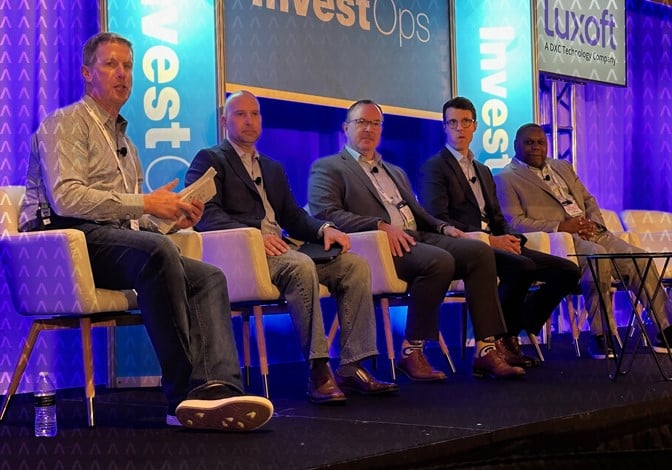
It has been a week since the FundGuard team returned from the InvestOps US conference in Orlando, and we are still buzzing from an energetic week of discussion, debate and networking with a record number of attendees.
Digitalization, Transformation and Cloud Technology were top of mind on every panel, and we were heartened to find the conversations have finally shifted from passive ”planning for the future” projections to more active and informed insights and sharing. In other words, the future is now and the industry is moving forward together.
This week’s post summarizes our key takeaways from the conference with a focus on the all-star keynote panel moderated by FundGuard President, John Lehner: Defining the Operating Model of the Future.
John was joined by fellow panelists, Walter Joyce – MD, Head of Investment Services, TIAA, James Kearney – Global Head of Investment Operations, Vanguard, Matthew Kelly – SVP Global Head of Digitization & Automation, Northern Trust Asset Management, and Jeff Ryan – Director Process Automation COE, BlackRock.
The group was brought together to discuss how organizations can leverage the latest data and technology capabilities to optimize their journeys to the cloud.
Aptly, John kicked off the conversation with an intro generated by chatGPT, which read:
“The world has seen a rapid shift towards digitalization in recent years and the asset management industry is no exception. As asset managers strive to stay competitive and meet changing customer demands, digital transformation has become a critical priority for many organizations.”
Nailed it.
As the panel agreed, reaching a true digital infrastructure is going to first require a complete make-over that must start with assumptions and requirements from across the investment management workflow. Some of these considerations, which we’ve covered in previous blogs, include:
Cloud-native SaaS operates under an assumption of continuous software delivery – and a perpetual state of readiness. This is a different starting point than the designs of monolithic relational database applications of the past, and as we learned from those on the panel, today’s organizations are still on their journey to true cloud native infrastructures. Even the largest firms are finding that their cloud-enabled technology has its limitations vs. a truly cloud-native approach. As one panelist noted, “The journey never ends.”
So, what advice did our panelists have for those embarking on their own paths to digitalization and cloud technology?
In summary: True digital transformation must start by creating a cloud-savvy consortium of change agents, clearly communicating your vision and collaborating across all stakeholders.
As this panel proved simply by taking the stage together, we must all be willing to work across the aisle to collectively solve pain points among commoditized processes. Reach out to your competitors. Attend forward-thinking industry events and encourage your service providers and vendor partners to facilitate cooperation.
It is no secret that we believe in a truly digital, back-to-front, cross-industry operating model that is driven by the use of cloud-native technology and AI. The asset managers we spoke with at InvestOps are now finally engaging with this vision and will be the first, along with their service providers, to collectively see the benefits to their organizations.
Better data, better analytics, more integration, and the ability to evolve quickly are all central to today’s customers, many of whom have already gone digital and expect the same from their service providers.
We look forward to continuing the discussion. Take a look at our events page to find where FundGuard will be next, and be sure to follow our News & Insights page for the latest thought leadership from FundGuard and our partners.
Sign up for FundGuard Insights

Your use of information on this site is subject to the terms of our Legal Notice.
Please read our Privacy Policy.